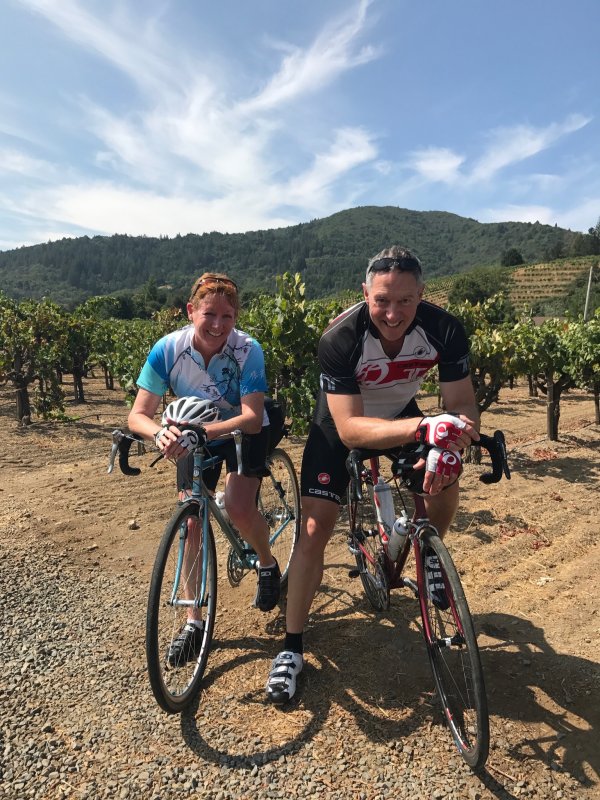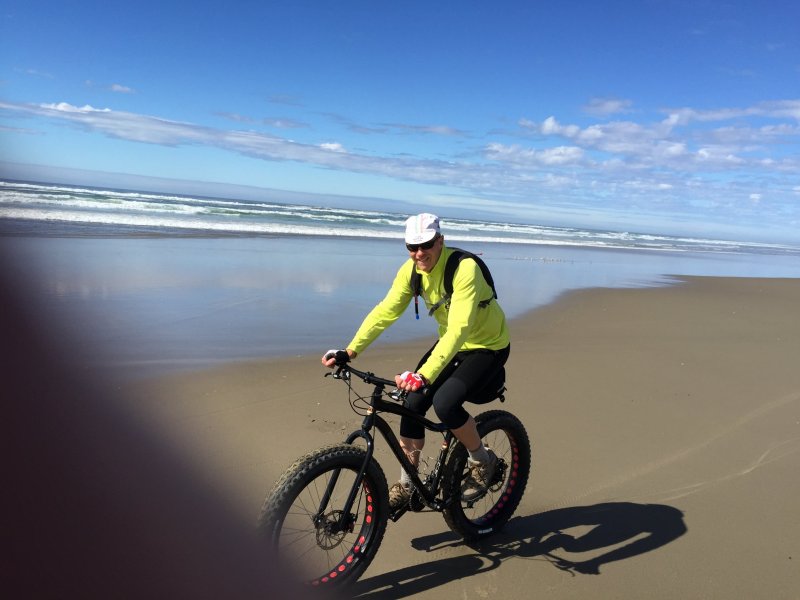{t is like sew-ups. Impractical for anything but racing. You still ran the risk of rolling it off the rim in a curb....easy: call home.
Just kidding, but I am NOT a fan of tubeless on the road. I was an early adopter, and what a joke. I waited a couple of years: still a hassle. And riding in winter in upstate NY? No way (but guys do it). Sucks, IMO. Bike shop guys periodically prod me to switch to modern tubeless. Nope. If I was still racing MTB (amateur), sure. Makes more sense. Road? Not going there (again).
Any cyclists here?
- Thread starter Keith_W
- Start date
You are using an out of date browser. It may not display this or other websites correctly.
You should upgrade or use an alternative browser.
You should upgrade or use an alternative browser.
...I had a flat on tubeless on my road-bike, about 20 miles from home, about 25 degrees F. And F is a key aspect of that experience. The juice was a sludgy mess. I wiped it out with dead oak leaves. Time I got all that sorted, I could barely feel my fingers. I put a spare tube in, and pinched it because I was so cold and couldn't get my fingers working. I ended up calling for a ride! That was a killer.
In 50 years, I had to call home once before: flatted my spare on tubulars...circa 1980.
In 50 years, I had to call home once before: flatted my spare on tubulars...circa 1980.
Hi,Yeah, I love the vintage bukes. Check this out.
Hi am a so called Bianchista which means Bianchi fan.
Rgds
Adelmo
I stay away from carbon because I want the frame to last. I ride a lot and not on the best surfaces... plus I'm a big fan of ancient British 3 speeds.I am old. The sport has passed ne by. Cannondale has a $15k racing bike. A flat criterium averaged 30+ mph. The sprint winner crossed the line at 43+mph.
The machines are a work of art. Science and engineering have descended on the sport exploding myths and intuition. The power meter is dominant. It has essentially replaced the speedometer and the heart monitor.
PED is hardly worth the risk. Given the advanced test methodology. IMO the final frontier is cheating the wind.
Enjoy.
With tubeless, flats are usually a lot easier than with inner tubes. Whether the tire is a road or MTB tire, the sealant is the first defense. If the puncture causes a total loss of air, you find the leak and use a tubeless tire repair kit not unlike the kind used for automotive tires. Usually the tire does not have to be taken off the rim- you do it while the tire is on the bike. Once the 'bacon strip' (a bit of sticky rubber or similar) is installed you re-inflate.With respect to tubeless I have no idea how handle a flat while on the road. Do you carry a spare tire. On mountain bikes they use a self-sealant. That is not always effective.
I don't recommend a tubeless setup unless you are on a long tour or racing. Its a good idea to remove the tire and clean it out about once every 4-6 months, which gets to be a pain, but if you are only doing that to one or two bikes annually its not a big deal.
Nice, i love my Jones.Comfort means you can ride longer and feel better at the end. Less pain in wrists, shoulders, neck — why beat the hell out of yourself? Bouncing and rattling does not equal speed. It took me a while — my Cyfac can only take 25s. I weigh 200lbs, so can’t remove all the air for pinch-flt reasons, but I went from 110psi to 85 with no speed penalty and a lot more comfort (running tubes). Felt weird for a time, but running with the fast boys I had no problem in the paceline. That was 5 years back, now I’m on my Jones a lot more often. 48mm @ around 26 psi. The penalty is the extra rotating weight out at the circumference—takes more effort to spin ‘em up, and climbing sure isn’t like on my Cyfac. I wish my 66 year old self bent into shapes I once did. I do miss those 25 mph rides with the fast boys on a Saturday club ride.
From this:
View attachment 121218
To this:
View attachment 121219
Many factors go into comfort.
1.Cacon is best
2. Pros want the s,allet frame possibe. you wanr your back fkat.
I was saving up fo a Merlin titanium or Colagno Masterlight{steel). I kind of wish more was done with titanium. It still amazes me what Cannondale achieved with aluminum. Most rides last 1-2 hours. The ride is over before fatigue sets in.
For road bikes and ultimate performance, I recommend clinchers and latex tubes. For flat protection you can stuff two tubes in your pocket along with some co2 cartridges. For longer trips you can store a foldable spare tire under your seat.
.
1.Cacon is best
2. Pros want the s,allet frame possibe. you wanr your back fkat.
My Kestral carbon was hit twice by a car. No damage to the bike. OTOHI stay away from carbon because I want the frame to last. I ride a lot and not on the best surfaces... plus I'm a big fan of ancient British 3 speeds.
With tubeless, flats are usually a lot easier than with inner tubes. Whether the tire is a road or MTB tire, the sealant is the first defense. If the puncture causes a total loss of air, you find the leak and use a tubeless tire repair kit not unlike the kind used for automotive tires. Usually the tire does not have to be taken off the rim- you do it while the tire is on the bike. Once the 'bacon strip' (a bit of sticky rubber or similar) is installed you re-inflate.
I don't recommend a tubeless setup unless you are on a long tour or racing. Its a good idea to remove the tire and clean it out about once every 4-6 months, which gets to be a pain, but if you are only doing that to one or two bikes annually its not a big deal.
For road bikes and ultimate performance, I recommend clinchers and latex tubes. For flat protection you can stuff two tubes in your pocket along with some co2 cartridges. For longer trips you can store a foldable spare tire under your seat.
.
Where are you getting this statistic? I know now, and have known all my life folks who ride for much longer than that every weekend, Saturday and Sunday. Maybe 1.5 - 2hrs on weeknights after work, but on the weekend they cover ground and spend all day doing it....Most rides last 1-2 hours.
There is a world of cyclists who aren’t competitive in any way just like riding their bikes. They’d be well suited to stay off race frames with flat back geometry. Yet thats what they see at the bike shop. Much too often i see middle age folks on race frame bikes who will never ride 18+ mph over any length of time. The industry is coming around somewhat - wide tires are a positive change. (But not those stiff sidewall tougher than truck tires models; you can’t soften those baby’s up even at 10psi.)
I’ve been a cyclist for over 50 years, cross continent tours and amateur racing. Theres more to cycling than going fast. Fast is fun no doubt. I used to live ”the Rules” (https://www.velominati.com/), particularly #5.
Don't' get your lycra in a bunch. I should have issued the following disclaimers. IMO.IME. YMMV. You know your cycling needs best. Make your choices accordingly. Even if you have to go vintage or custom. The good news is there is something for everyone.Where are you getting this statistic? I know now, and have known all my life folks who ride for much longer than that every weekend, Saturday and Sunday. Maybe 1.5 - 2hrs on weeknights after work, but on the weekend they cover ground and spend all day doing it.
There is a world of cyclists who aren’t competitive in any way just like riding their bikes. They’d be well suited to stay off race frames with flat back geometry. Yet thats what they see at the bike shop. Much too often i see middle age folks on race frame bikes who will never ride 18+ mph over any length of time. The industry is coming around somewhat - wide tires are a positive change. (But not those stiff sidewall tougher than truck tires models; you can’t soften those baby’s up even at 10psi.)
I’ve been a cyclist for over 50 years, cross continent tours and amateur racing. Theres more to cycling than going fast. Fast is fun no doubt. I used to live ”the Rules” (https://www.velominati.com/), particularly #5.
Enjoy the ride. Going slow allows you to look at something other than the butt of the rider in front of you.
On the topic of speed, I joined the local chapter (I’m in the ‘burbs) of a Toronto cycling club during the pandemic. Weekday rides left at 5:40 am but fortunately the meetup point was just up the street from my house. There’d usually be 10-15 of us in our group (there was also a faster ride group) and I got quite a rush out of going fast as part of a group. But it wasn’t relaxing in the slightest. First, I was pushing the upper range of my fitness trying to hang with the young bucks. Second, it was pitch black when we set out. Third, some new guys who I hadn’t ridden with before would occasionally ride with us so I needed to get used to their habits. Fourth, every little bump had to be called out down the pace line which, frankly, got annoying. And fifth, because the roads were pretty empty, we used to run lights and stop signs to keep the momentum going. I lasted a season. I liked pushing myself but realized that a crash would probably put me out for months. I’ve come to realize that I’m the sort of person who likes the apres ride social side of group rides, but I prefer to ride alone, at my pace, with my rules of the road.
Should Cannondale return to aluminum? Suppose they gave this treatment to their CAAD5 fame. They probably would have to design a new frame to accommodate disc brakes, etc. I think that was the last version. I believe the only advantage carbon would have would be comfort. The solution to that is gel. Cork handle bar tape, gel inserts for shoes, gloves and shorts would help. that with the trend toward low pressure tires. Remember most discomfort on the bike comes from trying to make the bike go fast.
Suppose Cannondale gave this treatment to an aluminum bike.
Suppose Cannondale gave this treatment to an aluminum bike.
...the marketplace wants carbon bikes (well I guess now we're supposed to lust for ebikes). The pros want carbon bikes. The psychological pressure for pros not thinking they are riding the fastest/lightest bike creates a lot of pressure for manufacturers... especially if they sponsor a team outright, or provide bikes to a team.
C'dale could do just about anything with aluminum to make a light, durable bike. Aluminum bikes don't have to be harsh, although they kind-of were back in the day. I still have a CAAD3 Saeco Team bike in the stable, and it rides great. If it had a little more room for a wider tire, even better, but that wasn't the flavor in '97/'98 when Super Mario was tearing it up.
C'dale could do just about anything with aluminum to make a light, durable bike. Aluminum bikes don't have to be harsh, although they kind-of were back in the day. I still have a CAAD3 Saeco Team bike in the stable, and it rides great. If it had a little more room for a wider tire, even better, but that wasn't the flavor in '97/'98 when Super Mario was tearing it up.
That’s kind of a big one, no?I believe the only advantage carbon would have would be comfort.
That’s kind of a big one, no?
Also... it's light, repairable, long fatigue life, doesn't require welding (the vast majority of fatigue failures happen at a weld), has superior impact resistance (it can, depending on the carbon used and design), and in terms of comfort, it can be designed to flex in whatever way the designer wants, and be stiff in areas where it improves efficiency and feel.
Given this, Al is clearly inferior except for cost. Steel and Ti have some advantages but overall can't match carbon if top performance is 1st priority.
It's the repairability of carbon that many miss. Carbon repair is a far more practical and easier option vs metal bikes. Metal has become nostalgic with many even touting the durability of Al, which is ridiculous as it's prone to fatigue failure and isn't easily repairable. I've cracked about 80% of Al frame mtbs I've owned.
I rode carbon and aluminum for years. Yes, carbon is more comfortable than aluminum. but I still needed gel.
Thanks for informing me that carbon can be repaired, I was told it could not be.
Cost is a big issue. It does not matter how good it is, if you can't bring it home. Aluminum is much more likely to survive a crash. I don't see carbon as easier. It requires a skilled craftsman to construct.
If you are racing you are going to crash eventually. That involves expensive repairs or replacement.
Comfort
if you are racing 1 -2 hour criterium I guarantee you will be uncomfortable no matter the bike you ride.
Note: I meant body fatigue. not frame fatigue.
i have ridden Aluminum bikes since college with no issue. All had lifetime warranty.
PS- There is no way carbon if stiffer than AL.
Thanks for informing me that carbon can be repaired, I was told it could not be.
Cost is a big issue. It does not matter how good it is, if you can't bring it home. Aluminum is much more likely to survive a crash. I don't see carbon as easier. It requires a skilled craftsman to construct.
If you are racing you are going to crash eventually. That involves expensive repairs or replacement.
Comfort
if you are racing 1 -2 hour criterium I guarantee you will be uncomfortable no matter the bike you ride.
Note: I meant body fatigue. not frame fatigue.
i have ridden Aluminum bikes since college with no issue. All had lifetime warranty.
PS- There is no way carbon if stiffer than AL.
...I wouldn't corner myself into defending one material over another. Speaking only for myself. No offense intended. But I do think we would need to define "performance" more precisely.
Touring the backcountry in India? Good luck with carbon repair there. You can find a welder "almost" anywhere. I think performance can have different definitions which may be purpose-driven, even cost-driven.
But I do know what you mean, Dave. An ultimate pro-race bike will be carbon. Although I am not aware of any pro-bike repairs to the carbon. Usually, the mothership wants stuff back for analysis. To make sure they don't have a big safety-recall issue hiding in the wild.
I swapped one of my carbon handlebars after a mild crash. For a privateer racer, not getting free gear from sponsors, an Al bar may be a better option, long-term. Frame? Tougher call...if you're racing.
One of the tri-guys I wrench for before big events, damaged his aero-carbon seat-tube by over-clamping an over-extended "sleeve." I did a lot of analysis on that for safety, but in the end, a place in the NW US did a primo repair, and he road that bike again at Ironman Lake Placid. So, there is a repairability aspect to carbon, but not usually a DIY project, although kits are available. Likewise, you can send your frame off and get a metal tube repair too.
Worst aluminum bike failure I have seen: garage fire. Fork was a molten slag heap.
Worst carbon bike failure: many. Usually due to impact (and not always high-speed).
I have steel, aluminum and carbon bikes. Still have my Raven carbon monocoque on a magnesium skeleton. I loved it. The marketplace did not.
No matter what it's made of: keep on riding.
Desperately needs love. And I need to sort my garage. Winter is here, and that means: Pugsley.
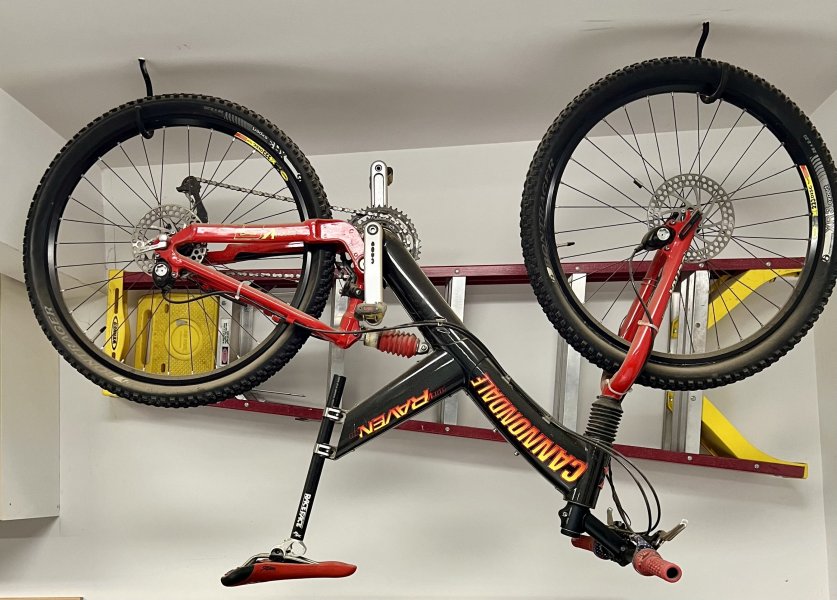
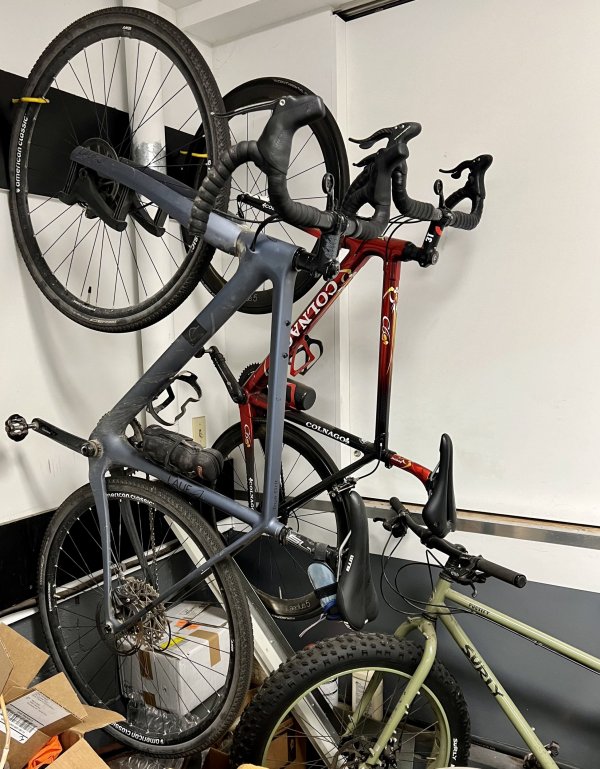
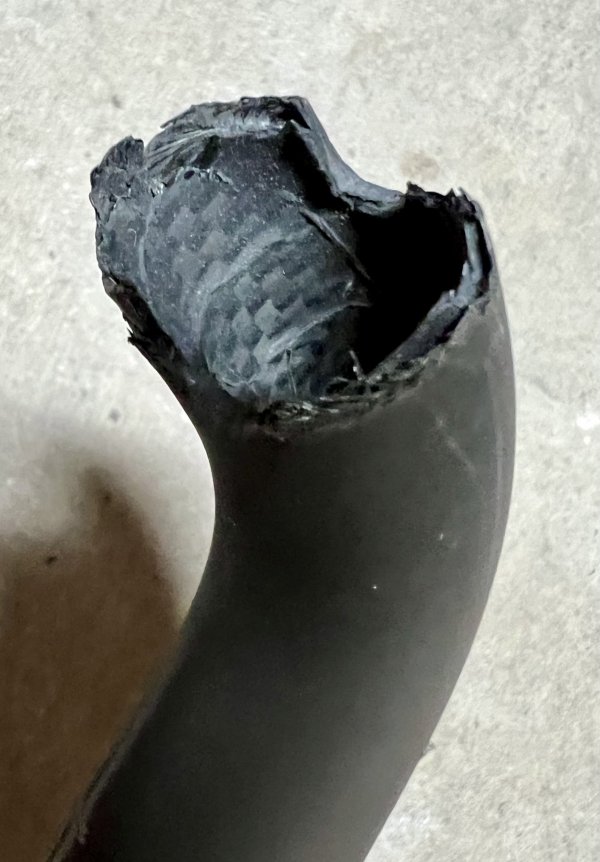
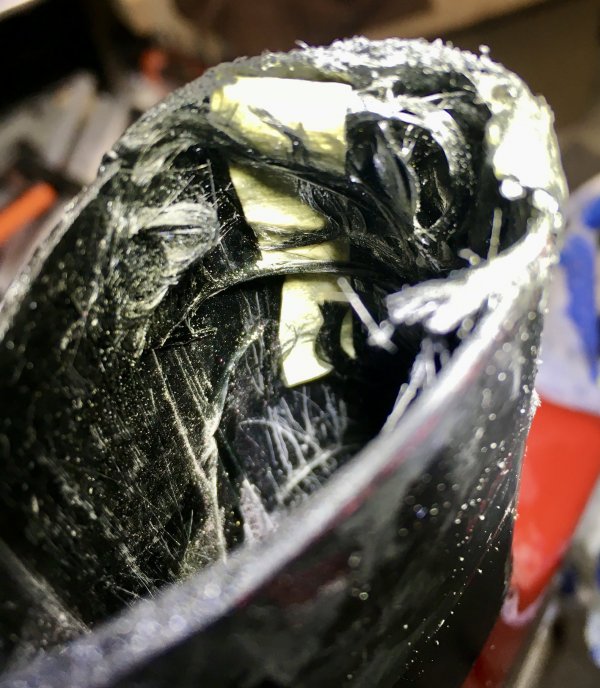
Touring the backcountry in India? Good luck with carbon repair there. You can find a welder "almost" anywhere. I think performance can have different definitions which may be purpose-driven, even cost-driven.
But I do know what you mean, Dave. An ultimate pro-race bike will be carbon. Although I am not aware of any pro-bike repairs to the carbon. Usually, the mothership wants stuff back for analysis. To make sure they don't have a big safety-recall issue hiding in the wild.
I swapped one of my carbon handlebars after a mild crash. For a privateer racer, not getting free gear from sponsors, an Al bar may be a better option, long-term. Frame? Tougher call...if you're racing.
One of the tri-guys I wrench for before big events, damaged his aero-carbon seat-tube by over-clamping an over-extended "sleeve." I did a lot of analysis on that for safety, but in the end, a place in the NW US did a primo repair, and he road that bike again at Ironman Lake Placid. So, there is a repairability aspect to carbon, but not usually a DIY project, although kits are available. Likewise, you can send your frame off and get a metal tube repair too.
Worst aluminum bike failure I have seen: garage fire. Fork was a molten slag heap.
Worst carbon bike failure: many. Usually due to impact (and not always high-speed).
I have steel, aluminum and carbon bikes. Still have my Raven carbon monocoque on a magnesium skeleton. I loved it. The marketplace did not.
No matter what it's made of: keep on riding.
Desperately needs love. And I need to sort my garage. Winter is here, and that means: Pugsley.




Last edited:
I would never ride a carbon handlebar. I am a big guy. Theyhave a habit of snapping for 150lb mountain goats. Think about a face plant at 40mph. Other than that, caron is fine. Just don't crush it in your bike stand.
Anyone that can do fiberglass can repair carbon. It might not be as pretty or light as a place that specializes in carbon repair, but it's not that difficult in general. Of course there are some things that can't be fixed.
With metals you're generally looking at a weld + heat treatment, which is rarely worth it because if the bike has one fatigue failure, others may not be far behind. It's unheard of for folks to repair Al mt bikes.
Also, carbon is rarely the most optimal it can be, your carbon bike and the carbon used in an F-35 fighter jet isn't necessarily of the same quality. The same could be said of design, carbon design has A LOT more going on than a brazed-lug steel frame, and the design of that carbon frame may not be as optimal as it could be, bike companies don't have the same funds to design as Lockheed. So there may be a lot of variation in material and design quality on a carbon bike the consumer just can't see. For example Trek uses impact resistant carbon on some parts of their mtbs and is able to test impact resistance, it's far greater vs Al. But off-brand company X may use cheaper carbon that has far inferior impact resistance. Carbon has a ton of design possibilities in so many ways. One example of this is Santa Cruz mt bikes use a different layup for every size frame so the smaller sizes have more flex vs the larger sizes, and they use a different rear triangle for every size too. Other brands don't do this and have the same rear triangle for every size. So unfortunately carbon isn't comparable to carbon, you have to look at the frame in question in a case by case basis which makes the whole thing a lot more involved for those who really care about the details.
With metals you're generally looking at a weld + heat treatment, which is rarely worth it because if the bike has one fatigue failure, others may not be far behind. It's unheard of for folks to repair Al mt bikes.
Also, carbon is rarely the most optimal it can be, your carbon bike and the carbon used in an F-35 fighter jet isn't necessarily of the same quality. The same could be said of design, carbon design has A LOT more going on than a brazed-lug steel frame, and the design of that carbon frame may not be as optimal as it could be, bike companies don't have the same funds to design as Lockheed. So there may be a lot of variation in material and design quality on a carbon bike the consumer just can't see. For example Trek uses impact resistant carbon on some parts of their mtbs and is able to test impact resistance, it's far greater vs Al. But off-brand company X may use cheaper carbon that has far inferior impact resistance. Carbon has a ton of design possibilities in so many ways. One example of this is Santa Cruz mt bikes use a different layup for every size frame so the smaller sizes have more flex vs the larger sizes, and they use a different rear triangle for every size too. Other brands don't do this and have the same rear triangle for every size. So unfortunately carbon isn't comparable to carbon, you have to look at the frame in question in a case by case basis which makes the whole thing a lot more involved for those who really care about the details.
Last edited:
Similar threads
- Replies
- 8
- Views
- 3K
- Replies
- 1
- Views
- 2K
- Replies
- 16
- Views
- 6K
- Replies
- 85
- Views
- 57K
- Replies
- 65
- Views
- 18K






